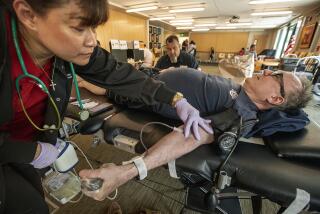Blood Supply Safe but May Be Inadequate
- Share via
The U.S. blood-banking industry has been repeatedly shaken by outbreaks of viral transmission, including the AIDS virus and three hepatitis viruses. In 1983, the risk of contracting the AIDS virus during a transfusion was a disturbing one in 100. Many people began to bank their own blood before elective surgery to cut down the risk that they would become infected.
But new techniques for detecting viruses in blood have cut the risk dramatically--so much so that the risks can no longer be measured but must be estimated using sophisticated mathematical techniques, researchers reported last week.
But the bad news, they added, is that the supply of donated blood is not keeping up with demand and that serious shortages are likely to occur as the average age of the U.S. population increases, necessitating increased medical care.
“Because of the high safety level, the effectiveness of donating one’s own blood for use during or after an upcoming operation, which does present a small risk to patients, is being called into question,” said Dr. Mark E. Brecher of the University of North Carolina at Chapel Hill, one of the study’s authors.
The team reported in Thursday’s New England Journal of Medicine that the risk of contracting HIV from a transfusion is now one in 676,000. The risks for hepatitis A, B and C are 1 in 1 million, 1 in 250,000, and 1 in 150,000, respectively.
The biggest risk of disease transmission, the team concluded, involves platelets, a form of white blood cell required by some cancer patients and trauma victims. Because platelets must be stored at room temperature, the risk of bacterial infection is about 1 per 12,000 bags. But because a typical transfusion requires several bags of platelets, the risk is actually somewhat higher.
Psychological Impact on Bank Tellers Noted
Bank tellers are rarely physically injured during holdups, but they can suffer psychological effects similar to those of combat veterans, according to new research in the February Journal of Occupational and Environmental Medicine.
Psychologist Jude Miller-Burke of United Health Care Corp. in Minneapolis and her colleagues studied 141 employees of 42 bank branches in an undisclosed city. All of the employees, they found, suffered some type of negative impact from the experience, ranging from increased stress to reduced productivity at work and problems with work or personal relationships.
On average, the workers reported post-traumatic stress-type symptoms after a robbery, including hyper-alertness, hyper-vigilance, difficulties with sleep or concentration, headaches and nightmares. Those workers who felt personally threatened during the robberies reported the greatest number of symptoms.
Schizophrenia Linked to Pregnancy Problems
Neurologists have long sought to understand the causes of schizophrenia, a devastating disease that affects about one in 100 people. Some studies have shown an association with viral infections in the victim’s mother during pregnancy. Others have indicated a genetic predisposition to the disease. A new study in Friday’s British Medical Journal indicates that problems during pregnancy may also cause the disorder.
Dr. Christina M. Hultman and her colleagues at the University of Uppsala in Sweden, a country that maintains extensive current and historical medical records, compared birth records of all children born from 1973 to 1979 with hospitalization records for schizophrenia patients.
They found that boys whose mothers had bleeding late in pregnancy had four times the normal risk of developing schizophrenia. Those who were smaller than normal at birth had 3.2 times the normal risk, and those who were a fourth child or later had 3.6 times the normal risk.
These data suggest, they speculated, that stresses to the fetus while still in the womb could impair brain development, leading to the disorder.
Rest Not Necessarily Best for Sciatica
Bed rest is the most commonly prescribed treatment for sciatica, which is characterized by shooting pains down the leg caused by a compressed nerve in the spine. A new study in Thursday’s New England Journal of Medicine, however, suggests bed rest is not particularly effective.
Dutch researchers sent half of 183 sciatica sufferers to bed for two weeks and gave the other half painkillers and encouraged them to get on with their lives. They found that, after two weeks, 70% of those in the bed rest group felt better, compared with 65% in the group not sent to bed. After 12 weeks, 87% of patients in both groups reported improvement.






